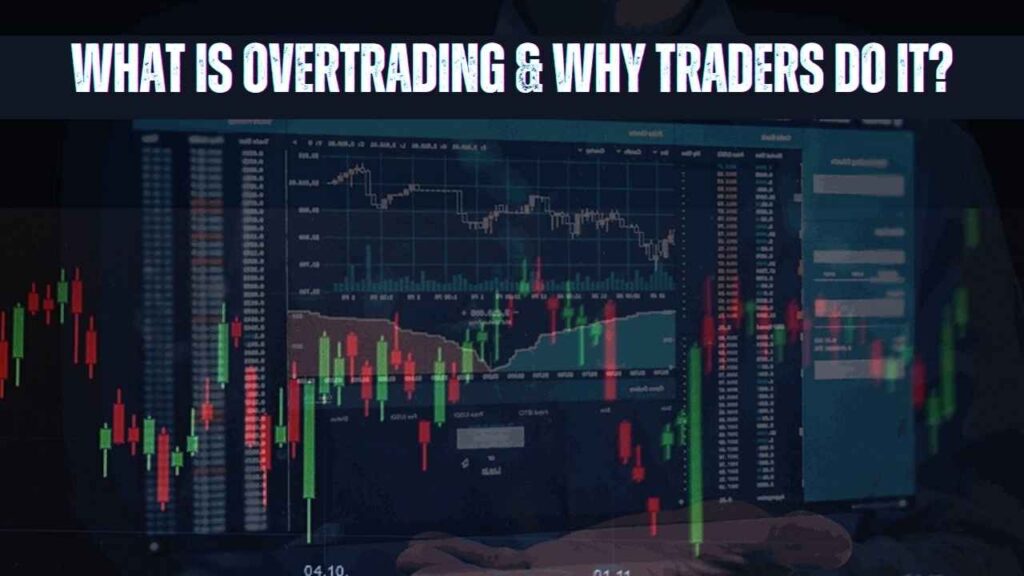For new traders, the thrill of the market can at times result in overtrading—executing more trades than required or risking too much on every trade. This emotional trading habit not only raises transaction costs but also puts your portfolio at greater risk. Knowing the idea of overtrading and why it happens is critical to creating a disciplined trading plan, controlling risk, and ultimately succeeding in the long run.

What is Overtrading?
Overtrading is the act of making too many trades, sometimes without a strong trading plan. It may come in two primary forms:
- Excessive Trade Frequency: Placing too many trades in a short period, driven by the desire to maximize profits or chase every market movement.
- Improper Position Sizing: Adding excessive positions to a winning trade or taking on too large a stake in an unproven market.
Both types of overtrading can result in substantial losses, increased transaction costs, and higher emotional stress. Instead of catching every slight opportunity, successful trading involves accuracy, discipline, and a good research-based strategy.
Why Do Traders Overtrade?
There are a variety of psychological and practical motives behind overtrading. Here’s a closer examination of such underlying reasons:
1. Emotional Triggers
- Greed:
Most of these traders are motivated by the urge to gain quick profits. The temptation of making speedy profits has the potential to lead them to take sizeable positions or trade impulsively. - Fear of Missing Out (FOMO):
Fear of missing a wonderful opportunity often results in traders moving into trades hurriedly, even if market conditions are not favorable. - Revenge Trading:
Following a loss, some traders seek to recover losses immediately by initiating further, generally high-risk trades. This emotional response can then rebound and increase losses even more. - Overconfidence:
Success in a succession of trades tends to over inflate a trader’s confidence, where they raise their position sizes with inadequate analysis. Overconfidence causes traders to underplay the risk and stray away from their intended trading plan.
2. Lack of a Trading Plan
Those who do not have a well-defined strategy or set of rules are more likely to overtrade. Without pre-established entry and exit points, position sizing, and risk levels, decisions tend to be made on impulse, resulting in frequent and unnecessary trades.
3. Mismanagement of Trading Capital
When traders do not handle their capital well, they may be inclined to “make up” for past losses by pushing their risks too high. This can build up into a pattern of overtrading where every next trade is a try to cover earlier losses, usually ending up as bigger dips.
Real-World Examples of Overtrading
Understanding overtrading can be easier with practical examples:
- Example 1: FOMO in Action
Suppose there is a trader, Alex, who observes a stock making steady upward moves and does not want to miss out on gains. Under the influence of FOMO, Alex places several trades during the day on the stock even when the signals are weak. Transaction costs accumulate, and when the stock has a small pullback, the aggregate losses due to overtrading greatly cut into Alex’s total profit. - Example 2: Revenge Trading
Let’s take the example of Sarah, who incurs a substantial loss on a trade because of a sudden market correction. Rather than taking a step back, Sarah goes ahead and places multiple new trades in hopes of recouping her loss. This instant reaction, revenge trading, actually increases her loss when the market keeps moving in the opposite direction. - Example 3: Overconfidence Post-Win
Following a string of successful trades, Mark feels omnipotent and takes on oversized positions. Without sticking to his initial risk management guidelines, Mark’s bigger positions bring huge losses when the market turns against him unexpectedly.
Tips to Avoid Overtrading
Adopting good strategies can prevent you from the mistakes of overtrading:
1. Develop a Clear Trading Plan
- Set Defined Rules:
Establish specific rules for when to enter and exit trades, how much capital to allocate per trade, and the maximum number of trades to take per day. - Risk Management:
Determine the percentage of your capital you’re willing to risk on each trade (e.g., 1-2%) and stick to it. Use stop-loss orders to protect against large losses.
2. Use a Trading Journal
- Record Every Trade:
Document each trade, including the reasons for entry and exit, the emotions you felt, and the outcome. A trading journal helps identify patterns in your behavior and highlights areas for improvement. - Review Regularly:
Analyze your trades regularly to see if overtrading is a recurring problem. Adjust your trading plan based on these insights.
3. Embrace Patience and Discipline
- Avoid Impulse Decisions:
Take time to analyze each trade and avoid the temptation to jump in because of market hype. Stick to your strategy and let high-quality trade setups develop. - Manage Emotions:
Recognize when emotions like fear, greed, or frustration are influencing your decisions. Consider taking a break from trading if you feel overwhelmed or excessively stressed.
4. Limit Trading Hours
- Set a Schedule:
Limit your trading to specific hours of the day to prevent burnout and impulsive decisions. Overtrading often occurs during extended periods of constant market monitoring. - Take Breaks:
Incorporate regular breaks into your trading routine to maintain a clear and focused mind.
5. Avoid Over-Leveraging
- Use Leverage Cautiously:
Leverage can amplify gains but also magnify losses. Ensure you understand the risks associated with high leverage and use it judiciously. - Stick to Your Budget:
Don’t allocate more capital than you can afford to lose. Adhering to strict position-sizing rules is essential for long-term success.
Final Thought
Overtrading is one of the most prevalent errors that can ruin even the most promising trading plans. By recognizing the triggers—FOMO, greed, and revenge trading—and using disciplined risk management techniques, you can prevent overtrading and establish a more consistent, effective trading approach. Keep in mind, trading isn’t about making more trades; it’s about making the right trades. With a good plan, proper risk controls, and concentration on quality rather than quantity, you can protect your capital and meet your long-term financial objectives.
Frequently Asked Questions (FAQ)
Q1. What is overtrading?
A: Overtrading is the excessive trading of orders beyond the trader’s pre-planned strategy, usually with the influence of emotions like greed, FOMO, or revenge after a loss.
Q2. Why do traders overtrade?
A: Overtrading is common among traders driven by emotional stimuli such as greed, FOMO, or revenge trading. Inadequate trading plan and excessive confidence following early profits may also lead to overtrading.
Q3. How can I prevent overtrading?
A: Create a firm trading plan with established entry and exit criteria, utilize stop-loss orders, keep a trading journal, set limitations to your trading time, and discipline your leverage.
Q4. Does overtrading affect my overall portfolio?
A: Yes, overtrading can dramatically drain your portfolio through high transaction costs, multiplied losses, and emotional toll, which may lead to questionable decisions.
Q5. Is it better to focus on fewer, high-quality trades?
A: Without question. A focus on quality, rather than quantity, helps you make carefully considered trading decisions and steer clear of rash action that can bring on huge losses.











